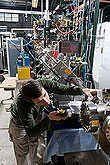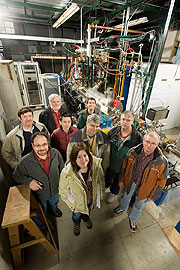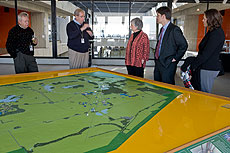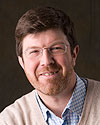|
Have a safe day!
Wednesday, Jan. 27
3:30 p.m.
DIRECTOR'S COFFEE BREAK - 2nd Flr X-Over
4 p.m.
Fermilab Colloquium -
One West
Speaker: Gino Segre, University of Pennsylvania
Title: A 1932 Meeting at Bohr's Institute:
The Birth of New Ideas in Physics
Thursday, Jan. 28
2:30 p.m.
Theoretical Physics Seminar - Curia II
Speaker: Stephen Martin, Northern Illinois University
Title: Extra Vector-Like Matter and the Higgs Mass in Supersymmetry
3:30 p.m.
DIRECTOR'S COFFEE BREAK - 2nd Flr X-Over
4 p.m.
Accelerator Physics and Technology Seminar - One West
Speaker: Shane Curry, SLAC National Accelerator Laboratory
Title: The BaBar Detector's Influence on Accelerator Operations
Click here for NALCAL,
a weekly calendar with links to additional information.
Upcoming conferences |
|
For information about H1N1, visit Fermilab's flu information site.
|
|
Wednesday, Jan. 27
- Breakfast: English muffin sandwich
- Portabello harvest grain
- Santa Fe chicken quesadilla
- Hoisin chicken
- Parmesan fish
- Cuban panini
- Assorted sliced pizza
- Pesto shrimp linguini w/leeks & tomatoes
Wilson Hall Cafe Menu |
|
Wednesday, Jan. 27
Lunch
- Chicken & vegetable stir fry w/ cashew rice
- Orange almond cake
Thursday, Jan. 28
Dinner
- Closed
Chez Leon Menu
Call x3524 to make your reservation.
|
|
|
HINS reaches test beam milestone
 |
| Jim Steimel, Fermilab engineer, inspects the HINS RFQ beam absorber. |
Fermilab has taken a major step toward laying the technical groundwork for Project X by creating a new test beam for superconducting radiofrequency cavities and components.
Earlier this month, the High Intensity Neutrino Source (HINS) collaboration successfully accelerated a proton beam to 2.5 MeV in a radiofrequency quadrupole accelerator, or RFQ, for the first time at Fermilab.
"This will provide a beam platform to facilitate development of components critical for Project X," says Bob Webber, APC/HINS Department head.
The 10-foot-long RFQ serves as the driving force of a proton linac in the Meson Detector Building. It will enable collaborators to test the ground-breaking application of superconducting radiofrequency (SRF) cavities for the acceleration of a high-intensity proton beam from very low energies.
“On the first attempt the the RFQ achieved the design acceleration,” says Giorgio Apollinari, head of Fermilab’s Technical Division. “This type of technical achievement is the groundwork that will support Fermilab’s research in the second decade of this century.”
The RFQ uses strong electrical fields to accelerate ionized hydrogen into a low-energy proton beam. That beam will then accelerate through 18 copper, room-temperature cavities up to a minimum energy compatible with the superconducting cavities that make up the remainder of the linac. The cavities use stored radiofrequency energy to accelerate particles as they pass.
In February 2009, the HINS collaboration successfully tested the first 325-MHz single-spoke resonator SRF cavity. Collaborators expect to become the first group in the world to accelerate beam through this type of cavity using the RFQ as a beam source. This would lay the ground work for stringing many cavities together to create a unique linear accelerator for discovery at the intensity frontier.
Read more
--Tona Kunz
 |
| Members of Fermilab's Technical Division, Accelerator Division and Accelerator Physics Center helped the HINS collaboration reach a RFQ milestone. Back row from left: Steve Hays and Jim Steimel. Middle row from left: Giorgio Apollinari, Dehong Zhang, Vic Scarpine and Brian Fellenz. Front row from left: Salah Chaurize, Andrea Saewert and Bob Webber. |
|
DOE environmental officials tour Fermilab
 |
| A group of officials from the Department of Energy's Office of Environmental Policy and Assistance (HS-22) in Washington, D.C. get a 15th-floor tour on Wednesday, Jan. 13. The tour followed a workshop attended by Fermilab staff and the Fermi Site Office staff at Argonne National Laboratory, given by HS-22 on the topic of a new executive order addressing federal leadership in environmental, energy and economic performance. From left: John Yates, Facilities and Infrastructure Division director, Department of Energy's Office of Science; Denny Parzyck, DOE Fermi Site Office; Jane Powers, environmental protection specialist,HS-22; Josh Silverman, deputy director, HS-22; and Kim Fowler, research engineer, PNNL. |
|
Science and engineering indicators 2010: Public attitudes regarding S&T
From AIP FYI, Jan. 26, 2010
The recently-released "Science and Engineering Indicators 2010" has an insightful chapter on the public's understanding of science, and attitudes about scientists and S&T. The chapter commented on the importance of the public's attitudes as follows:
"Generalized public support for S&T can make a difference in many ways. Public openness to technological change gives U.S. businesses opportunities to build a domestic customer base, create a foundation for worldwide technical competitiveness, and foster the national advantages that flow from pioneering innovations. Broad public and political support for long-term commitments to S&T research, especially in the face of pressing immediate needs, enables ambitious proposals for sustained federal S&T investments to reach fruition. Public confidence that S&E community leaders are trustworthy, S&E research findings are reliable, and S&E experts bring valuable judgment and knowledge to bear on public issues permits scientific knowledge to have influence over practical affairs. In addition, positive public perceptions of S&E occupations encourage young people to pursue S&E careers."
Read more
|
|
|
A memorable transition into the new year
Giorgio Apollinari, head of the Technical Division, wrote this week's column.
 |
Giorgio Apollinari |
The last two months have been extremely rewarding for the Technical Division and its efforts to develop future accelerator technologies. We finished the first superconducting radio frequency cavities that meet ILC specifications, set a record for the magnetic field produced by a new type of superconducting magnet, and-on the first try-met the 2.5-MeV design goal for a new acceleration device for high-intensity proton beams. What a great way to finish the old year and ring in the new.
- In December, the first two 1.3-GHz cavities, installed by TD staff in separate helium vessels, exceeded the ILC goal of an acceleration gradient of 31.5 MeV/m. We then shipped the dressed cavities to KEK, where members of our division worked elbow-to-elbow with their Japanese and European colleagues to assemble a truly international ILC cryomodule. These achievements have established Fermilab on the international scene as a capable builder of high-performance SRF cavities and cryomodules.
- The first 4-meter-long niobium-tin (Nb3Sn) quadrupole magnet for the US LHC Accelerator Research Program achieved a magnetic field of 200 Tesla/m on Dec. 4. In cooperation with other DOE laboratories, Fermilab TD staff made major contributions to the multi-year development of the superconducting cables, tools and assembly techniques that led to this milestone. The team also received essential support from the High Field Magnet R&D program at Fermilab. Now that we possess the know-how to build long Nb3Sn superconducting magnets, we can look confidently toward potential upgrades of the LHC accelerator and the development of powerful magnets for proposed accelerators such as a muon collider.
- On Jan. 13, members of the High Intensity Neutrino Source program at Fermilab operated for the first time a 325-MHz radio frequency quadrupole to accelerate particles. On the first attempt, the RFQ achieved (see adjacent article) the design acceleration of 2.5 MeV. The HINS program is a joint effort by the Accelerator Division, Accelerator Physics Center and TD. It will enable us to use proton beams to test SRF cavities and help us advance the design and development of Project X.
These technical achievements are the groundwork that will support Fermilab's research in the second decade of this century. They will allow us to tackle the intensity and energy frontiers that lie in front of us.
|
ES&H weekly report, Jan. 26
This week's safety report, compiled by the Fermilab ES&H section, includes one first-aid injury and no recordable injuries. The first-aid injury involved an employee who slipped and fell on ice. We have now worked 33 days since the last recordable injury. Find the full report here.
Safety report archive
|
Galaxies unlock new secrets of dark matter
From MSNBC, Jan. 26, 2010
To weigh the universe, scientists use two kinds of cosmic scales: one to measure all the regular matter out there, and another to deduce how much invisible dark matter remains hidden underneath.
These calculations have been taken further than ever before by a new study that tallied both types of mass in smaller and more distant groups of galaxies than any previous projects. The project found that these faraway galactic clusters have roughly the same proportion of dark matter to regular matter as the closer galaxy groups do.
Read more
|
|